Sleep Plus Stages™ sleep tracking
Sleep Plus Stages automatically tracks the amount and quality of your sleep and shows you how long you spent in each sleep stage. It gathers your sleep time and sleep quality components into one easily glanceable value, sleep score. Sleep score tells you how well you slept compared to the indicators of a good night’s sleep based on the current sleep science.
Comparing the components of the sleep score to your own usual level help you recognize which aspects of your daily routine may affect your sleep and may need adjusting. Nightly breakdowns of your sleep are available on your watch and in the Polar Flow app. Long-term sleep data in the Polar Flow web service helps you analyze your sleep patterns in detail.
How to benefit from Sleep Plus Stages?
By tracking your sleep with Sleep Plus Stages you:
- get insights into the amount and quality of your sleep
- get a sleep score that gives glanceable feedback on how well you slept
- see how different components of the sleep score compare to your own usual level
- see your sleep structure in detail including sleep stages, interruptions and the number of full sleep cycles
- can learn how your lifestyle and habits affect your sleep
What are the components of the sleep score?
The Sleep Plus Stages measurement is based on recording the movements of your non-dominant hand with a built-in 3D acceleration sensor and recording your heart’s beat-to-beat interval data from your wrist with an optical heart rate sensor. Your sleep score is a number that summarizes how much and how well you've slept. The scale of the sleep score is 1 - 100. A typical sleep score is around 70 to 85.
The six components of the sleep score are grouped under three themes: amount, solidity and regeneration. Each bar in the sleep graph represents the score for each component. Sleep score is the average of these scores.

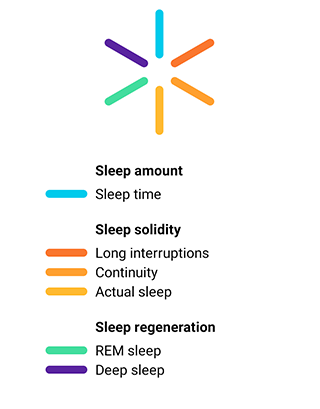
How are sleep amount and sleep solidity measured?
Sleep amount looks at how long you've slept. Getting enough sleep is crucial to your well-being. Your sleep time is compared to the optimal sleep time based on your preferred sleep time setting and the age-related sleep duration recommendations (7 - 9 h for adults). Sleep time tells you the total duration between when you fell asleep and when you woke up. On average, adults sleep for 7 h 20 min, with women sleeping slightly longer than men. Your usual level shows how this component was usually scored during the past 28 days.
Sleep solidity looks at the quality of your sleep in terms of the number and pattern of interruptions in your sleep. Your usual level shows how this component was usually scored during the past 28 days. A good night's sleep consists of long, uninterrupted periods. However, it's perfectly normal to have some interruptions in your sleep - in most cases you won't even remember being awake. The components of the solidity theme are evaluated against the indicators of good sleep quality based on the current sleep research literature.
- Long interruptions (min) tells the time you spent awake during the interruptions longer than 90 seconds. Interruptions in sleep are perfectly normal. During a normal night's sleep there are numerous short and long interruptions when you awaken from your sleep. Whether you remember these interruptions or not depends on their duration. The shorter ones we don’t usually remember. The longer ones, for instance when one might get up for a sip of water, we can remember. There are about 15 minutes of long interruptions in sleep during an average night. A night without any long interruptions gives the maximum score for this component.
- Continuity (1-5): Sleep continuity is a rating of how continuous your sleep was on a scale of 1 to 5. 5 represents sleep without any interruptions. Values higher than 3 reflect long stretches of sleep with occasional interruptions. Values lower than 3 reflect sleep in short segments with several interruptions. The average value for adults is 3.2. Lower values are common when you sleep longer, as sleep becomes lighter after the most pressing need for sleep has been met.
- Actual sleep (%) Actual sleep is your sleep time minus interruptions. It shows in percentages how much of your night was spent asleep. For adults, the average value for actual sleep is 93 %. The closer the value is to 100 %, the higher the score for actual sleep.
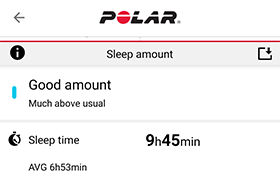
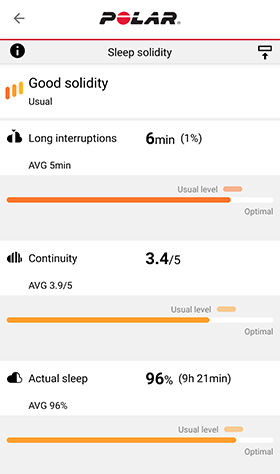
Your sleep time is the longest continuous rest time that takes place within 24 hours starting from 18:00/6pm to next day’s 18:00/6pm. Breaks shorter than one hour in your sleep don't stop sleep tracking, but they are not taken into account in the sleep time. Breaks longer than one hour stop sleep time tracking.
How are sleep stages measured?
A healthy adult normally goes through 4-5 sleep cycles over the course of a night. Normally sleep cycles proceed from light sleep into deep sleep, and then back to REM sleep. Sleep regeneration looks at the quality of your sleep in terms of the proportions of restorative sleep stages: REM sleep and deep sleep. REM sleep is important for learning and memory. Deep sleep restores your body. A healthy sleep structure contains a good amount of both REM sleep and deep sleep. Your usual level shows how this component is usually scored during the past 28 days. The components of the regeneration theme are evaluated against the indicators of good sleep quality based on the current sleep research literature.
- REM sleep %: REM stands for rapid eye movement. In REM sleep, your muscles are relaxed but your brain is active. REM sleep restores your mind, and enhances memory and learning. This is the stage when dreaming mostly occurs. Most REM sleep occurs during the second half of the night. The amount of REM sleep is on average about 21 % of sleep time for adults. 25 % gives the maximum score from this component of sleep score. Higher or lower percentages decrease your score.
- Deep sleep %: Deep sleep is the stage of sleep when it's hardest to be woken up. This sleep stage restores your body, supports your immune system and affects muscle growth. It also affects certain aspects of memory and learning. Most deep sleep occurs during the first half of the night. On average, deep sleep accounts for about 15 % of sleep time for adults. Roughly 17 % gives you the maximum score for this sleep score component. Higher or lower percentages decrease your score.
- Light sleep %: Light sleep serves as a transition stage between wakefulness and the deeper stages of sleep. You can be easily awoken from light sleep since your responsiveness to the environmental stimuli remains quite high. Light sleep also promotes mental and physical recovery, although REM and deep sleep are the most important sleep stages in that regard.

Sleep rhythm: Regular bedtimes teach your body to anticipate sleep, which makes falling asleep easier when it's time. Keeping your bedtimes consistent is one of the simplest tricks to get the optimal amount of all the necessary sleep stages. A consistent sleep rhythm reinforces a healthy sleep structure.
Why should you track your sleep?
Sleep plays an important role in optimal recovery. Many of the body’s restorative functions, such as muscle growth and tissue repair, occur mostly during sleep. Sleep is also important for the mental side of recovery: the amount and quality of sleep have a profound impact on learning and memory as well as mood and motivation.
When you want to improve or fine-tune your sleep, tracking it on a regular basis is the first step. Sleep tracking can help you identify the factors in your day that may have a negative impact on your sleep. You will also learn which daily routines and choices improve the quality of your sleep.
How much sleep do you need?
There isn't one specific amount of sleep that is right for everyone. Sleep and the required amount of rest are very individual and affected by several factors like training load, stress, your body’s condition and individual differences. The recommended sleep range for adults is 7 to 9 hours. The optimal amount of sleep for you is the one that leaves you feeling alert and full of energy to perform at your best at work, when training and in your daily life activities.
Discover the optimal amount of sleep you need by tracking your actual sleep time and focusing your attention on how you feel. You can record your own perception of your sleep in the morning by rating it. You can do it on your watch or in the Flow app. Your own rating is not taken into account in the sleep score calculation, but you can record your own perception and compare it to the sleep assessment you get. If you're feeling tired or having trouble recovering from your workouts, you could try if you'd benefit from a longer night's sleep. Remember to adjust your preferred sleep time accordingly to keep the feedback accurate.
If you feel you’re not getting enough sleep, a good approach is trying to gradually add 15 minutes each day until you wake up feeling rested on a regular basis. Another way to determine your sleep need is to allow yourself to sleep until you wake up naturally over a period of several days, preferably while on vacation. Go to bed at a consistent time and don't use an alarm clock. Over this period, the amount of sleep should level off at a consistent number of hours, which is the amount of sleep you need.
How to start tracking sleep with Polar Sleep Plus Stages™?
- The first thing you need to do is set your preferred sleep time in the Polar Flow or on your watch. In the Flow app, tap your profile, and choose Your preferred sleep time. Choose your preferred time and tap Done. Or sign into your Flow account or create a new one at flow.polar.com, and choose Settings > Physical settings > Your preferred sleep time. Set your preferred time and choose Save. Set your preferred sleep time on your watch from Settings > Physical settings > Your preferred sleep time.
 Sleep time preference is the amount of sleep you want to get each night. By default, it is set to the average recommendation for your age group (eight hours for adults from 18 to 64 years). If you feel that eight hours of sleep is too much or too little for you, we recommend you adjust your preferred sleep time to meet your individual needs. By doing this, you’ll get accurate feedback on how much sleep you got in comparison to your preferred sleep time.
Sleep time preference is the amount of sleep you want to get each night. By default, it is set to the average recommendation for your age group (eight hours for adults from 18 to 64 years). If you feel that eight hours of sleep is too much or too little for you, we recommend you adjust your preferred sleep time to meet your individual needs. By doing this, you’ll get accurate feedback on how much sleep you got in comparison to your preferred sleep time. - Wear your watch when sleeping. You don’t need to enable a sleep mode, your watch will automatically detect when you’re sleeping. Make sure that Continuous HR tracking or Night-time only HR tracking is on. To enable Continuous HR tracking go to Settings > General settings > Continuous HR tracking. Tighten the wristband firmly around your wrist. The sensor on the back of the watch must be in constant touch with your skin. For more detailed wearing instructions, see Wrist-based heart rate measurement.
- Your watch detects when you fall asleep, when you wake up and how long you spent sleeping. The Sleep Plus Stages measurement is based on recording the movements of your non-dominant hand with a built-in 3D acceleration sensor and recording your heart’s beat-to-beat interval data from your wrist with an optical heart rate sensor.
- In the morning you can see your sleep score from your watch. You get sleep stages information (light sleep, deep sleep, REM sleep) and a sleep score after one night, including feedback on themes (amount, solidity and regeneration). After the third night, you get a comparison to your usual level.
- You can record your own perception of your sleep quality in the morning by rating it on your watch or in the Flow app. Your own rating is not taken into account in the sleep score calculation, but you can record your own perception and compare it to the sleep assessment you get.
Nightly breakdowns and weekly summaries of your sleep data in the Polar Flow app
How you sleep is always individual — instead of comparing your sleep stats to others, follow your own long-term sleeping patterns to get a full understanding of how you sleep. Sync your watch with the Flow app after waking up to see your last night’s sleep data in Polar Flow. Follow your sleep on a daily and weekly basis in the Flow app, and see how your sleeping habits and activity during the day affect your sleep.
Choose Sleep from the Flow app menu to see your sleep data. In the Sleep structure view you see how your sleep has progressed through different sleep stages (light sleep, deep sleep and REM sleep) and any interruptions to your sleep. Usually sleep cycles proceed from light sleep into deep sleep and then to REM sleep. Typically, a night's sleep consists of 4 to 5 sleep cycles. This equals to approximately 8 hours of sleep. During a normal night's sleep there are numerous short and long interruptions. The long interruptions are displayed with the tall orange bars in the sleep structure graph.

The six components of the sleep score are grouped under three themes: amount (sleep time), solidity (long interruptions, continuity and actual sleep) and regeneration (REM sleep and deep sleep). Each bar in the graph represents the score for each component. Sleep score is the average of these scores. By choosing the weekly view you can see how your sleep score and sleep quality (solidity and regeneration themes) vary during the week.



Sleep rhythm section provides a weekly view to your sleep time and sleep stages.

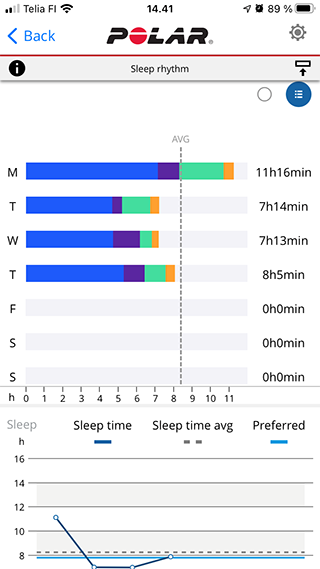
You can also rate your sleep yourself. You can rate how well you’ve slept last night with a five-step scale: very poorly - poorly – okay - well - very well. Your own rating is not taken into account in the sleep score calculation, but you can record your own perception and compare it to the sleep assessment you get.

Long-term sleep data in the Polar Flow web service
To view your long-term sleep data with sleep stages in the Flow web service go to Progress, and choose the Sleep report tab.
Sleep report gives you a long-term view of your sleep patterns. You can choose to view your sleep details for a 1-month, 3-month or 6-month period. You’re able to see averages for the following sleep data: fell asleep, woke up, sleep time, REM sleep, deep sleep and interruptions to your sleep. You can view a nightly breakdown of your sleep data by hovering your mouse over the sleep graph.
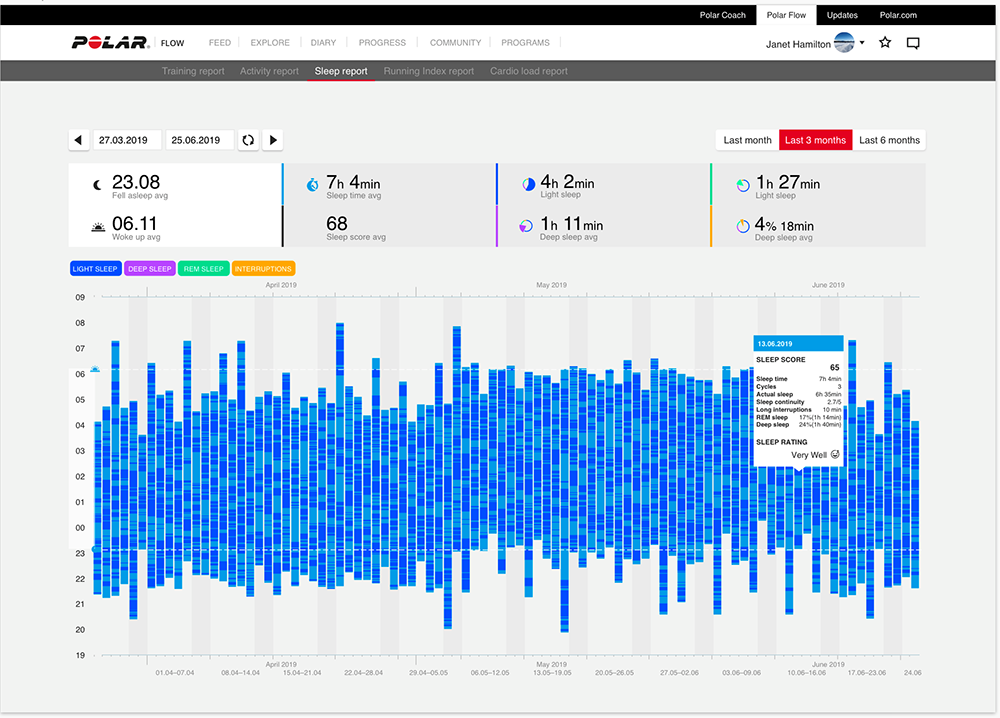
Scientific background
In sleep science and medicine, the polysomnography is the gold standard method to assess sleep. It measures brain activity, eye movements and muscle activity with a large set of sensors attached to the head. According to the American Academy of Sleep Medicine, the rules of classifying sleep into different sleep stages require that a sleep technician analyses the signals in 30-second epochs.
Polar’s automatic sleep measurement with the Sleep Plus Stages algorithm has been validated against the gold standard method. The Sleep Plus Stages algorithm incorporates signals from an acceleration sensor and an optical heart rate sensor in the watch. Accurately measuring the heart’s beat-to-beat intervals with an optical wrist sensor is the foundation of determining sleep stages. Classifying sleep into light, deep and REM sleep relies on variation in the heart’s beat-to-beat intervals. A recent independent study compared Polar’s automatic sleep measurement against the polysomnography. The results demonstrated that the Sleep Plus Stages algorithm was able to determine sleep stages with a reasonable degree of accuracy in healthy adults with normal sleep (unpublished).
Sleep data on Polar Grit X
For more information see Sleep data on your watch in the Polar Grit X User manual.
Sleep data on Polar Grit X Pro
For more information see Sleep data on your watch in the Polar Grit X Pro User manual.
Sleep data on Polar Grit X2 Pro
For more information see Sleep data on your watch in the Polar Grit X2 Pro User manual.
Sleep data on Polar Ignite
For more information see Sleep data on your watch in the Polar Ignite User manual.
Sleep data on Polar Ignite 2
For more information see Sleep data on your watch in the Polar Ignite User manual.
Sleep data on Polar Ignite 3
For more information see Sleep data on your watch in the Polar Ignite 3 User manual.
Sleep data on Polar Pacer
For more information see Sleep data on your watch in the Polar Pacer User manual.
Sleep data on Polar Pacer Pro
For more information see Sleep data on your watch in the Polar Pacer Pro User manual.
Sleep data on Polar Unite
For more information see Sleep data on your watch in the Polar Unite User manual.
Sleep data on Polar Vantage M
For more information see Sleep data on your watch in the Polar Vantage M User manual.
Sleep data on Polar Vantage M2
For more information see Sleep data on your watch in the Polar Vantage M2 User manual.
Sleep data on Polar Vantage V
For more information see Sleep data on your watch in the Polar Vantage V User manual.
Sleep data on Polar Vantage V2
For more information see Sleep data on your watch in the Polar Vantage V2 User manual.
Sleep data on Polar Vantage V3
For more information see Sleep data on your watch in the Polar Vantage V3 User manual.